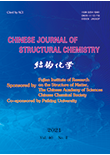Synthesis, Structure and Photophysical Properties of a Dinuclear Copper(I) Complex Based on Phosphino- pyridine and Diphosphine Mixed-ligands
YU Wen-Si, HUANG Chun-Hua and HUANG Xi-He*
Chin. J. Struct. Chem. 2021, 40, 175-181 DOI: 10.14102/j.cnki.0254-5861.2011-2788
February 15, 2021
copper(I) complex, thermally activated delayed fluorescence, crystalline structure
ABSTRACT
Treatment
of bis(diphenylphosphino)methane (dppm) and 2-(diphenylphosphanyl)pyridine
(dpppy) with Cu(CH3CN)4BF4 afforded a
dinuclear Cu(I) complex [Cu2(dpppy)2(dppm)(CH3CN)](BF4)2·3CH2Cl2 (1). Complex 1 was structurally characterized by X-ray single-crystal analysis
and its photophysical properties were studied in detail. It
crystallizes in triclinic space group P with a = 13.0834(8), b = 13.5568(8), c =
21.8544(11) Å, α = 76.090(5)°, β = 80.803(5)°, γ = 64.582(6)°, V = 3391.3(3)
Å3, Z = 2, Mr = 1507.42, Dc = 1.476 g/cm3, F(000) = 1532, GOOF = 1.071, the final R = 0.0700 for 9041 observed reflections
with I > 2σ(I) and wR = 0.2063 for all data. The complex contains a Cu2-core structure surrounded by one dppm and two dpppy ligands in a
head-to-head arrangement. In the crystalline phase, complex 1 exhibits bright bluish-green photoluminescence (λmax = 488 nm) with high
quantum yield (ϕ = 0.57) at room
temperature. It is still a relatively high emission quantum yield (ϕ = 0.36) in doped PMMA thin film with
20 wt% dopant of complex 1. The emission peaks of 1 in dichloromethane solution and doped
PMMA (20 wt%) thin films are 510 and 494 nm, respectively, showing a very
slight bathochromic shift compared to that in crystalline phase. This phenomenon might be
attributed to its rigid conformation that precludes the possible distortion of
copper centers in the excited state.








